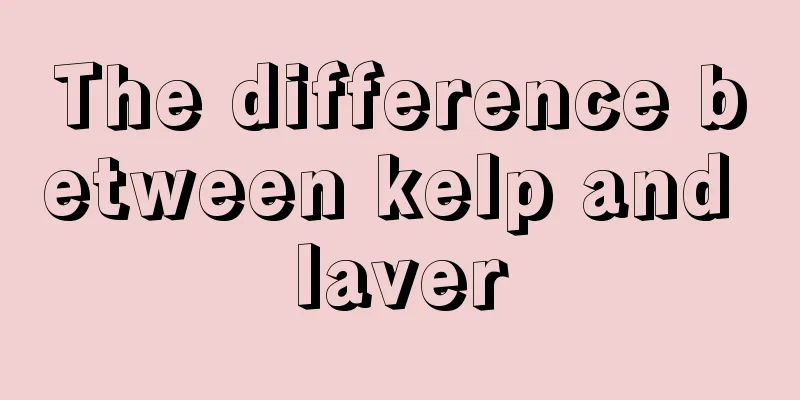The difference between kelp and laver

|
Kelp and laver are two common seafoods and are also foods that many people like to eat. Kelp and laver have certain similarities, so some people cannot distinguish between them. In fact, there are certain differences between kelp and laver. The two are different in both nutritional value and shape. Below, I will introduce to you in detail the differences between nori and kelp. 1. Nutritional value of kelp Kelp is a vegetable with high nutritional value. Every 100 grams of dried kelp contains: 8.2 grams of crude protein, 0.1 grams of fat, 57 grams of sugar, 9.8 grams of crude fiber, 12.9 grams of inorganic salts, 2.25 grams of calcium, 0.15 grams of iron, as well as 0.57 milligrams of carotene, 0.69 milligrams of thiamine (vitamin B1), 0.36 milligrams of riboflavin (vitamin B2), 16 milligrams of niacin, and can provide 262 kcal of calories. Compared with spinach and rapeseed, except for vitamin C, its content of crude protein, sugar, calcium and iron is several times or even dozens of times higher. Kelp is a type of seaweed that is high in iodine. Cultured kelp generally contains 3-5% iodine, and can reach 7-10%. 2. Nutritional value of seaweed Nori is not only delicious but also rich in nutrients, especially high in iodine. Therefore, it was used in ancient times to treat goiter caused by iodine deficiency, which is now called "thyroid enlargement". Since seaweed has the function of softening and dispersing lumps, it can also be eaten by people with other congestion. Nori is rich in bile alkaloids, which have the effect of enhancing memory. Because it contains a certain amount of mannitol, it is a strong diuretic and can be used as a supplementary food for the treatment of edema. Nori is rich in calcium and iron. It is not only an excellent food for treating anemia in women and children, but also can promote the growth and health of bones and teeth in children and the elderly. 3. The difference in shape between kelp and laver Kelp is a large marine brown algae plant that grows in low-temperature seawater. It belongs to the Phaeophyceae, Laminariaceae. The sporophyte is large, brown, flat and ribbon-shaped, and can be up to 20 meters long. It is divided into leaf blade, petiole and holdfast, and the holdfast is in the shape of a rhizoid. Porphyra is a general term for the mutualistic algae in the sea. Rhodophyta, Rhodophyceae. The algae body is membranous and is called a thallus. Purple or brownish green. The shape varies with the species. Porphyra is a marine red algae. The thallus consists of a single layer of cells embedded in a thin layer of colloid and is dark brown, red or purple. The holdfast of laver is disc-shaped and the rhizoids are thread-like. It grows on rocks in shallow intertidal zones. There are many varieties, the main ones are striped laver, kelp, sweet laver, etc. |
<<: Can natto lower blood sugar?
Recommend
How to make Chinese cabbage fried bean cake
Nowadays, more and more people realize that diet ...
How to make spicy sauce chicken head
We must develop the habit of cooking, so as to pr...
How to make quick fried rice noodles
Food, clothing, housing and transportation are im...
How to make spicy squid shreds
Diseases caused by diet can’t be bought back. If ...
How to make shrimp and egg stew?
Shrimp is rich in iodine and protein, which is a ...
How to make glutinous red bean paste rolls
Food is the most important thing for people. Only...
Pumpkin pie (rice cooker version)
Whether we eat well or not affects our health and...
How to make egg mushroom
Are you still eating the same monotonous meals in...
How to make pea sausage sticky rice
For you who study and work hard every day, the gr...
How to make rice cake fish
You take us to a restaurant and we almost drool w...
How to make spicy and sour radish and cabbage
For middle-aged and elderly people, half of their...
How to make QQ purple potato balls
Of course, healthy and delicious food is insepara...
How to make mushrooms with soy sauce
The world is so beautiful, how can you bear to ma...
How to make goose meat soup
Goose meat is high in protein and appetizing, mak...
How to make lettuce and black fungus
Most of the food out there is delicious, but do y...









